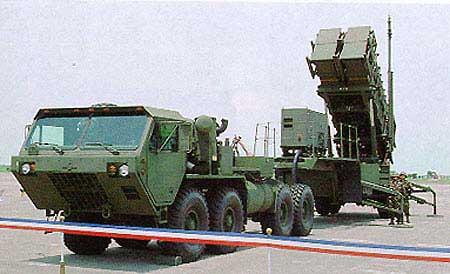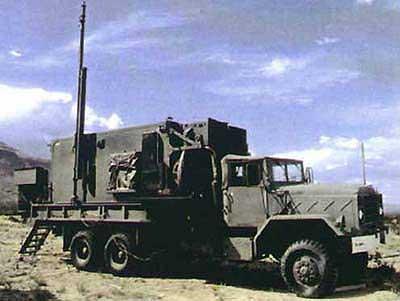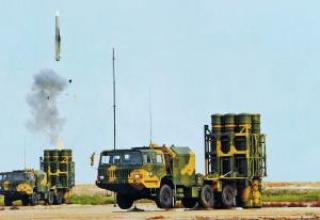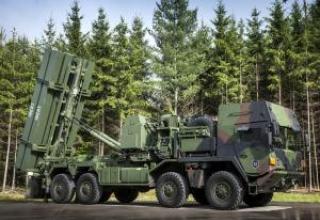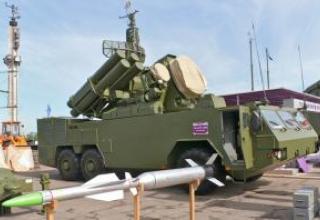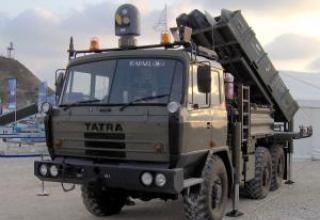Patriot" SAM systems are designed to cover large administrative and industrial centers, naval and air bases from all existing airborne attack means in conditions of strong electronic counteraction of the enemy. The complex is capable of simultaneously detecting and identifying more than 100 air targets, continuously escorting eight selected of them, preparing baseline data for firing, launching and pointing up to three missiles at each target.
The development of the complex was started in 1963 to replace the SAMs of the previous generation. The first flight test of the missile took place in February 1970, and January 11, 1974 the missile was the first to perform guidance maneuvers on commands received from the ground radar. The complex was adopted for service with the U.S. Army in 1982.
The anti-aircraft battery includes 4-8 launchers (PU) with four missiles each. The battery is the minimum tactical-fire unit, which can, independently perform the combat mission. The battery is most often used in a division.
The Patriot SAM system has high combat capabilities, is in the U.S. service and is considered a promising complex to equip the armed forces of other NATO countries. The efficiency of the complex is achieved by building it on the basis of advanced circuit solutions, the use of modern materials and advanced technologies in SAM systems and units.
The main technical solutions that characterize SAM systems include the following:
- multifunction radar with phased array and electronic beam scanning;
- combined directional control system (radio command - in the middle section of the trajectory and "guidance through the missile" - in the final section) allows, due to the transfer of onboard computer functions to the ground equipment of the complex and reducing the required range of target acquisition significantly reduce the multi-dimensional characteristics of GSN and the cost of onboard equipment of the directional control system, while ensuring high accuracy, inherent in self-guided missiles.
- Considerable reach zones and high speeds of SAM reach.
Composition:
It's part of the "Patriot" complex:
- multifunctional radar station with phased antenna array AN/MPQ-53;
- fire control station AN/MSQ-104
- launchers M901
- anti-aircraft guided missiles MIM104;
- power supply sources AN/MSQ-26;
- communication facilities, technological equipment;
- means of radio technical and engineering camouflage.
MIM-104A surface-to-air missile system used in Patriot air defense systems is a single-stage guided missile made under a normal aerodynamic scheme.
The rocket consists of the following compartments (from the bow to the tail): fairing, CNS, combat unit, engine, control system (control unit, 4 cross-clad stabilizer and 4 steering wheel with hydraulic drives).
The shroud provides protection of the GSP from high aerodynamic loads and thermal flows at hypersonic flow rate. The cowl is made of ceramic alloy by special casting. The nose part of the cowl is covered with cobalt alloy. The thickness of the cowl is more than 120mm.
Under the cowl is a flat radar antenna GSP (diameter 305mm), mounted in a cardan suspension on an inertial platform. Behind it there is the MDAGS guidance system, which consists of two blocks - a guidance unit on the final section of the TSG and a modular guidance unit on the middle section (MMP).
The MMP guidance unit is located in a combat unit section and contains navigation devices and on-board computer. In the warhead compartment there is also an inertial sensor, auxiliary electronic equipment, including a signal converter, fuse actuation mechanism and a shrapnel-phase BC with fuse and antennas. The rocket uses Thiocol's TX-486 solid fuel single-mode engine. Two cables run on the outer side of the engine, which transmit signals from the guidance system to the control system located in the tail of the missile. The average thrust of the engine is 11000 kgf and the operating time is 11.5 seconds. The engine casing is part of the missile casing, but has additional thermal protection. The engine contains a charge of conventional solid fuel, fastened to the walls. The fuel is ignited by a pyrotechnic system located in the front part of the engine housing. There are four hydraulically driven steering wheels around the engine nozzle. In this section there is a battery, oil tank, compressed air cylinder, electric pump and a unit that creates high pressure. The rocket has no wings, the aerodynamic lift force is created directly by the fuselage.
At maneuvering an overload can make more than 25 units. The missile's systems are monitored with the help of built-in instruments. A fault message is automatically transmitted to the fire control system computers.
Air defense missiles are delivered in the factory packaging, in the TPK rectangular section. The SAM is located in the TPK on two rails. Containers are made of aluminium sheets mounted in a welded frame. The front of the container is closed with a rubber lid reinforced with fiberglass, which is pierced by a rocket during start-up, and at the back - with a lid made of solid fiberglass, which is completely removed by gases emanating from RDTT.
The flight is controlled by a combined guidance system. At the initial stage of flight software control is implemented, on the average - radio command, on the final - by the method of TVM (Track-via-missile - escort through the missile), which combines command guidance with semi-active. The use of this method of guidance has significantly reduced the sensitivity of the system to various electronic countermeasures, and made it possible to organize the flight of the missile on the optimal trajectories and hitting targets with high efficiency.
The essence of the TVM method is as follows. In the process of pointing the missile at the target with the help of radar AN/MPQ-53, simultaneous tracking of the target and 3UP is performed. Reflected from the target radar signals are perceived by the antenna MDAGS and its defined angular coordinates of the line of sight of the target are transmitted through the RF channel to a special antenna radar and enter the computer fire control center. The signals received by the radar directly from the target are also sent to the computer, which are compared with the signals received from the SSD.
Based on the analysis carried out during the comparison of these signals, guidance commands for the missile are generated and transmitted to the main beam of the radar. After conversion on board the LLRS, these commands are transmitted to the rudder control drive, as well as to the MDAGS antenna drives to ensure continuous target tracking.
Fire control station AN/MSQ-104
The fire control point - the command point of the Patriot SAM system - is located in a special container and mounted on the chassis of the M814 vehicle. Inside the idol of one wall there are communication equipment and one operator's workplace, along the other - a computer, a data transmission terminal, the workplace of the second operator and auxiliary equipment.
Battle control consists of two operators. Each operator's workplace has an air situation indicator with a diameter of 53 cm, a control unit indicator, a set of key switches to enter and output the operator the necessary information to control fire in the process of combat work, as well as a unit to monitor the functioning of the equipment complex.
The left ARM indicator shows the general, situation in the zones of detection, control and fire of the SAM battery, and the right indicator shows the information on control of all elements of the SAM battery and the current air situation. The use of special service equipment makes it possible to perform diagnostic control of individual devices and the entire SAM system even during the battle.
Multifunctional radar AN/MPQ-53 is mounted on a two-axle semi-trailer weighing 15 tons and transported by wheeled tractor M818. The work of the radar is largely automated - its maintenance is carried out from the control room of the combat calculation of two operators. The station provides almost simultaneous detection, identification and tracking of 90 to 125 air objects in a given sector and flight control of all SAMs aimed at the targets. The integrated AN/TPX-46(V)7 requestor is used to identify targets.
The maximum target detection range when viewed from 0 to 90o by angle and azimuth in sector 90o is 35-50 km (with a target flight height of 50-100 m) and up to 170 km (1000-10000 m). This is achieved by using a phased array antenna and a fast computer that controls the station's operation modes at all stages.
The control system allows to use Patriot SAM system together with E-3 "Centri" long-range detection and control aircraft. In this case "Patriot" is in radar silence mode until the last moment, receiving target designation from the airborne AWACS.
In the hiking position, the antenna system is placed on the roof of the cabin. Selecting the sector of the radar operation is done by turning the cabin in the required direction. When the cockpit is fixed, the radar is capable of searching and detecting azimuth targets in sector 90o, and escorting and guiding missiles in sector 110o.
A characteristic feature of the radar is the transformation of signals into digital form, which made it possible to use the computer to control the operation modes of the station. Electronic scanning of the lattice antenna pattern is achieved by changing the phases of the emitted high-frequency signals using phase rotators.
The radar transmitter generates and amplifies in accordance with the control signals the high-frequency oscillations, which differ depending on the mode of station operation by type of modulation, duration and frequency of pulse repetition, power and operating frequency. The power of generated signals is tens of kilowatts, and in a pulse duration of several tens of milliseconds exceeds hundreds of kilowatts. To increase the range resolution of the radar, a method of pulse compression in dispersion delay lines is implemented in the signal receiving and processing device. The operating modes of the transmitter are changed with the help of the computer in millionths of a second.
In the work of the radar applied the principle of sealing for probing, receiving and processing signals over time. The whole viewed area is divided into 32 separate sections, each of which at line-by-line scanning one by one is viewed by the PHAR beam, and the duration of the working cycle of the station at each section is 100 µs, if possible to change the operating mode of the radar from cycle to cycle.
Most of the work cycle time is spent on searching for targets in a given sector, and less on tracking targets and directional sounders. The whole operation period of the radar for search and maintenance of targets, as well as for target tracking is 3.2 seconds. The radar also has a mode of operation in which the air situation is not controlled in the entire 32-section area, but only in those areas where air targets are most likely to appear.
The M901 launcher is designed to launch, transport and temporarily store missiles. It is mounted on a two-axle semitrailer M860 and transported by a wheeled tractor. The launcher includes an elevating boom, mechanisms for lifting missiles and pointing them at azimuth, power supply unit, a drive to install a radio mast, which serves to receive commands and transfer data to the fire control station, an electronic unit and communication equipment.
As soon as the command is received for launch, the necessary data are entered into the rocket's memory device. When the "launch" button is pressed on the operator's console, power is supplied to the control system equipment, after which the ground computer of the fire control station automatically switches on the missile control system, performs the necessary calculations and prepares the flight algorithm.
The reaction time of the SAM system is minimized primarily due to the pre-turn of the PU arrow in the direction of the intended attack, as well as due to the minimal time loss for the missile to reach the flight path. When the booster is mounted on the ground, a certain sector of space is assigned to each booster, and these sectors are repeatedly overlapped. This achieves the all-around firing of Patriot air defense systems, as opposed to air defense systems using vertically launched missiles, which turn towards the target after the missile is launched.
It should be noted that the vertical launch option was considered during the development of the 3UP MIM-104. However, this option was abandoned because such equipment was not used on U.S. missiles of this size at that time.
Characteristics:
| Maximum range for intercepting the target, km | 80 (in sector 90 o) |
| Minimum intercept range, km. | 3 |
| Maximum altitude of target interception, km | 24 |
| Minimum height of target interception, km | 0,06 |
| Number of simultaneously fired targets | 8 (in sector 90 o) |
| Probability of hitting the target | 0.8 (in combat conditions 0.4-0.6) |
| Mass of the rocket, kg | 912 |
| Mass of the rocket in the TPC, kg | 1696 |
| Diameter, m | 0,41 |
| Length, m | 5,31 |
| Speed, M | 3-5 |
| Maximum transverse overloads g | 30 |
| Management | By means of cross-shaped stabilizing tail planes |
| Swing of stabilizers, m | 0,87 |
| Engine | RDTT ТХ-486 firms Thiocol |
| Engine traction | 13 |
| Engine running time, sec. | 12 |
| Guidance System | |
| In the middle section | Radio team |
| At the end of the line. | Radiolactic TVM |
| BC | shrapnel-foot |
| Battle Charge BC | Normal explosive substance |
| Fuse | ХМ818, non-contact |
| Габариты контейнера, м | 0.99*1.09*6.1 |
| Weight BC, kg | 70 (РАС-1) 90 (РАС-2) |
| Deployment time from the march, mines | 30 |
Testing:

Since 1983, these air defense systems are in service with the U.S. ground forces, were supplied to America's NATO allies, as well as Israel, Saudi Arabia and Japan. The Patriot gained wide popularity during the Gulf War. And not even because it proved to be a reliable means of air defense, but because of skillfully organized advertising campaign. By the way, not a single enemy plane was shot down by them. But the volume of their sales after that war was about $3 billion, according to the manufacturer.
During the war in the Persian Gulf area, Patriot SAMs were used to fight Iraqi tactical missiles Scud. Their use required a warning from a reconnaissance satellite about the launch of the missile and the trajectory of its flight. This data had to be received at least 90 seconds before the warhead appeared on the radar screen. Typically, the interception was performed at altitudes of 5-10 km at a distance of 7-15 km from the battery position. Moreover, the warhead was not always destroyed completely, but only changed its flight path. The target could also be hit by fragments from the destroyed warhead due to the proximity of its interception. In real combat conditions, the effectiveness of the complexes turned out to be twice lower than the results of range tests: the probability of hitting the target was from 0.4 (according to the Soviet General Staff estimates) to 0.6 (according to the Pentagon), against the range of 0.8 - 0.95. In addition, Patriot often killed Scud actually on the ground, at the target, only increasing the damage to the object of attack. This, of course, required a serious improvement of the complex, especially its software. In particular, in addition to the main RAS-1 warhead designed to engage conventional air targets, the RAS-2 warhead was designed specifically to engage tactical ballistic missiles.
The purpose of the Patriot upgrade was to adapt the SAM system to defend small areas against tactical ballistic missile strikes. The objective of this version of the SAM system was not only to ensure that the tactical ballistic missile deviated from the target point, but also to destroy it. To that end, the software was refined, which also made it possible to combine the activities of the 3 Hawk and Patriot SAM systems under common control of a single fire control point. In the course of modernization, the missile's combat unit was improved and a new fuse was installed, the mass of projectiles was increased from 2 to 45 years. These changes did not affect the effectiveness of the missile when shooting at aerodynamic targets and later became standard for all missiles to be upgraded.
The PAC-2 variant was tested at the White Sands test site in November 1987, when a modified Patriot missile was hit by another Patriot missile that simulated the Soviet SS-23 ballistic missile.
As part of the second stage of the RAS-2 modernization, in the early 1990s, the GEM (Guidance Enhanced Missile) program developed a missile with an improved targeting system, including an advanced radio detonator. This improved the combat capabilities of the Patriot SAM system for intercepting the TBR.
At the same time, the QRP (Quick Response Program) provided for modification of the AN/MPQ-53 radar software in order to improve its capabilities when intercepting TBR. According to Reitheon's specialists, this allowed to increase the area defended by Patriot's SAMs against the TBR by 4 times as compared to the RAC-1 option.
Raytheon offers another modernization of the Patriot complex by creating a new version of the missile, designated as RAS-2 direct hit (RAS-2 Hit-to-Kill). The proposal to perform this upgrade is made in order to give the early versions of the system in service a direct hit capability similar to that of the RAS-3 missile, as well as to increase their strike capability.
The upgrade involves the replacement of the passive COS of the existing PAF-2 missiles by the active Ku-band, the replacement of the fragmentation fragmentation warhead and the introduction of a special propulsion system. The missile's software will also undergo modernization. The new components will provide the missile with the ability to manoeuvre during the pointing phase of the target before collision with it, as well as to destroy attacking ballistic or cruise missiles, aircraft and UAVs. The choice of RAS-2 for these purposes is due to its longer range and altitude compared with RAS-3. The use of active CLO can make it possible to implement scenarios of over-the-horizon intercepts.
Together with RAF-3, the Hit-to-Kill rocket could ensure that Patriot systems are in service until 2028. The US Army's SLEP program will include upgrades of the RAF-2 and PAC-2GEM missile variants to the PAC-2GEM+ configuration. This option will include a high-explosive fragmentation warhead, an improved in-flight reprogrammable radio fuse and a surface acoustic oscillator to improve the effectiveness of cruise missile countermeasures.
Sources:
- "Зарубежная военная техника. Обзоры" НТЦ "Информтехника" Выпуск 2(126) Ракетная техника 1991 год.
- Вестник ПВО
- Фирма Raytheon предлагает очередную модернизацию компонента "ПЭТРИОТ"
